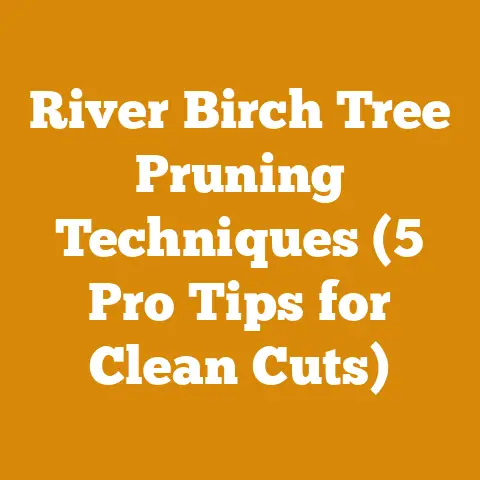Battery Walk Behind String Trimmer (5 Pro Tips for Precision Cutting)
In today’s interconnected world, we’re constantly looking for ways to make our lives easier and more efficient. Smart homes, with their automated lighting, temperature control, and security systems, represent the pinnacle of this pursuit. But what about the tasks that take us outdoors, away from the comfort of our digitally enhanced living spaces? Maintaining our lawns and gardens, for instance, often requires manual labor and specialized tools. And that’s where battery-powered equipment, like the walk-behind string trimmer, steps into the spotlight. Today, I’m diving deep into the world of battery-powered walk-behind string trimmers, offering you five pro tips to achieve precision cutting and a manicured lawn you’ll be proud of.
The Rise of Battery-Powered Lawn Care Equipment
The global lawn and garden equipment market is booming, with a projected value of over $35 billion by 2025. A significant portion of this growth is fueled by the increasing popularity of battery-powered tools. Why the shift? Well, for starters, they’re quieter, cleaner, and require less maintenance than their gasoline-powered counterparts. Plus, battery technology has advanced significantly in recent years, offering longer run times and more power.
From my own experience, I remember the days of wrestling with pull cords and inhaling fumes from my old gas trimmer. Switching to a battery-powered model was a game-changer. The convenience, the reduced noise, and the lack of emissions made yard work far more enjoyable.
Battery Walk-Behind String Trimmer: 5 Pro Tips for Precision Cutting
Walk-behind string trimmers, also known as wheeled string trimmers or lawn edgers, offer a unique solution for tackling tough weeds, overgrown grass, and edging along fences and sidewalks. Their larger size and wheeled design provide stability and ease of use, making them ideal for larger properties or those with uneven terrain. Here are my top five tips for achieving precision cutting with your battery-powered walk-behind string trimmer:
1. Mastering the Machine: Understanding Your Trimmer
Before you even think about firing up your walk-behind string trimmer, it’s crucial to understand its components and how they work. This isn’t just about reading the manual (though, please do that too!). It’s about getting hands-on and familiarizing yourself with the machine.
- Battery Type and Capacity: Know your battery! Is it lithium-ion, nickel-cadmium, or something else? What’s its voltage and amp-hour rating? This will determine the run time and power output of your trimmer. For example, a 40V 5Ah battery will generally provide longer run times than a 20V 2Ah battery.
- Cutting Head and String Type: Different trimmers use different types of cutting heads and strings. Some use a bump-feed system, where you tap the head on the ground to release more string. Others use an automatic feed system. The string itself can vary in thickness and shape (round, square, twisted). Experiment to find the best string for your needs. I’ve found that thicker, twisted string works best for tough weeds and brush.
- Wheel Height Adjustment: Most walk-behind string trimmers have adjustable wheel heights. This allows you to customize the cutting height and adapt to different terrain. Lower settings are ideal for close trimming, while higher settings are better for tackling tall grass and weeds.
- Safety Features: Familiarize yourself with the safety features of your trimmer, such as the safety guard, the on/off switch, and any overload protection mechanisms. Always wear appropriate safety gear, including eye protection, hearing protection, and closed-toe shoes.
Data Point: According to a study by the Consumer Product Safety Commission (CPSC), over 20,000 injuries related to lawn and garden equipment are reported each year. Proper training and safety precautions can significantly reduce the risk of injury.
2. The Art of the Trim: Technique is Key
Using a walk-behind string trimmer isn’t just about pushing it back and forth. Mastering the proper technique is essential for achieving a clean, professional-looking cut.
- Start with the Right Stance: Position yourself comfortably behind the trimmer with a firm grip on the handle. Maintain a balanced stance and avoid leaning too far forward or backward.
- Controlled Movement: Move the trimmer slowly and deliberately, overlapping each pass slightly to ensure complete coverage. Avoid jerky movements or sudden stops, as this can result in uneven cutting.
- Edging Techniques: When edging along fences, sidewalks, or flower beds, angle the cutting head slightly to create a clean, defined edge. Use a slow, steady pace and avoid bumping the trimmer against hard surfaces.
- Tackling Tough Weeds: For thick, stubborn weeds, use a side-to-side sweeping motion to gradually cut them down. Avoid trying to cut through them in a single pass, as this can bog down the trimmer and damage the string.
- Cutting Direction: When possible, cut with the growth direction of the grass or weeds. This helps to prevent the string from bending the grass over and leaving an uneven cut. If the grass is going in different directions, make sure you go in both directions for a cleaner cut.
Personal Story: I once tried to rush through a trimming job and ended up with a patchy, uneven lawn. It took me twice as long to go back and fix my mistakes. Lesson learned: slow and steady wins the race!
3. Battery Management: Maximizing Run Time and Lifespan
Battery-powered tools are only as good as their batteries. Proper battery management is crucial for maximizing run time and extending the lifespan of your battery.
- Charging Practices: Always follow the manufacturer’s recommendations for charging your battery. Avoid overcharging or undercharging, as this can damage the battery cells. Use the charger that came with your trimmer or a compatible charger recommended by the manufacturer.
- Storage Tips: Store your battery in a cool, dry place away from direct sunlight and extreme temperatures. Avoid storing it in a fully discharged state, as this can lead to irreversible damage. Aim for a charge level of around 40-60% for long-term storage.
- Run Time Optimization: To maximize run time, avoid using the trimmer at full power unless absolutely necessary. Reduce the cutting width or raise the wheel height to decrease the load on the battery. Also, keep the cutting head clean and free of debris.
- Battery Rotation: If you have multiple batteries, rotate them regularly to ensure even usage and prevent any one battery from being overused.
- Understanding Battery Indicators: Pay attention to the battery level indicator on your trimmer. When the battery is running low, stop trimming and recharge it to avoid damaging the battery.
Unique Insight: Lithium-ion batteries have a limited number of charge cycles. Each time you fully charge and discharge the battery, you use up one cycle. By following proper charging and storage practices, you can significantly extend the lifespan of your battery and get more value for your money.
4. String Selection and Maintenance: The Cutting Edge
The string is the heart and soul of your walk-behind string trimmer. Choosing the right string and maintaining it properly is essential for achieving a clean, efficient cut.
- String Thickness: String thickness is measured in diameter, typically ranging from 0.065 inches to 0.155 inches. Thinner strings are suitable for light trimming, while thicker strings are better for tackling tough weeds and brush.
- String Shape: String shape can also affect cutting performance. Round strings are the most common and are suitable for general trimming. Square strings provide a more aggressive cut and are better for thick weeds. Twisted strings offer a balance of durability and cutting power.
- String Material: Most trimmer strings are made from nylon, but some are reinforced with other materials, such as Kevlar or metal. Reinforced strings are more durable and resistant to breaking.
- String Replacement: Learn how to replace the string on your trimmer. This is a basic maintenance task that you’ll need to perform regularly. Follow the manufacturer’s instructions for loading the string onto the spool.
- String Maintenance: Keep your string clean and free of debris. If the string becomes frayed or worn, replace it immediately. Store your string in a cool, dry place to prevent it from drying out and becoming brittle.
Real Example: I once used a cheap, low-quality string on my trimmer and it kept breaking every few minutes. It was incredibly frustrating and time-consuming. Switching to a higher-quality string made a world of difference.
5. Troubleshooting and Problem Solving: When Things Go Wrong
Even with the best planning and preparation, things can sometimes go wrong. Knowing how to troubleshoot common problems can save you time and frustration.
- Trimmer Won’t Start: Check the battery level and make sure the battery is properly installed. Also, check the on/off switch and any safety interlocks.
- String Breaks Frequently: Use a thicker string or switch to a reinforced string. Also, avoid cutting too close to hard surfaces.
- Trimmer Bogs Down: Reduce the cutting width or raise the wheel height. Also, check the cutting head for debris and make sure the string is properly loaded.
- Uneven Cutting: Adjust the wheel height and use a slow, steady pace. Also, make sure the string is properly trimmed and the cutting head is clean.
- Overheating: If the trimmer overheats, stop using it and allow it to cool down. Check the motor for debris and make sure the air vents are clear.
Case Study: A local landscaping company was experiencing frequent breakdowns with their battery-powered walk-behind string trimmers. After analyzing their usage patterns and maintenance practices, I discovered that they were consistently overcharging their batteries and using low-quality string. By implementing proper charging practices and switching to a higher-quality string, they were able to significantly reduce their downtime and extend the lifespan of their trimmers.
Going Beyond the Basics: Advanced Techniques and Considerations
Once you’ve mastered the basics of using a battery-powered walk-behind string trimmer, you can explore more advanced techniques and considerations to take your lawn care to the next level.
1. Creating Clean Lines: The Art of Edging
Edging is the process of creating a clean, defined line between your lawn and other surfaces, such as sidewalks, driveways, and flower beds. A well-edged lawn can significantly enhance the overall appearance of your property.
- Choosing the Right Edger: While your walk-behind string trimmer can be used for edging, you may also consider investing in a dedicated lawn edger. Edgers are designed specifically for creating clean lines and often feature a blade or cutting wheel that rotates vertically.
- Preparing the Area: Before edging, clear away any debris, such as rocks, sticks, and leaves. This will help to prevent damage to your edger and ensure a clean cut.
- Edging Technique: Hold the edger firmly and guide it along the edge of the surface you’re edging. Use a slow, steady pace and maintain a consistent depth. Overlap each pass slightly to ensure complete coverage.
- Creating a Beveled Edge: For a more professional look, consider creating a beveled edge. This involves angling the edger slightly to create a sloping edge.
2. Mulching and Composting: Turning Waste into Gold
Grass clippings and weed trimmings can be a valuable resource for your garden. Mulching and composting are two ways to turn this waste into nutrient-rich soil amendments.
- Mulching: Mulching involves spreading a layer of organic material, such as grass clippings, around your plants. Mulch helps to retain moisture, suppress weeds, and regulate soil temperature.
- Composting: Composting is the process of decomposing organic matter, such as grass clippings, leaves, and food scraps, into a nutrient-rich soil amendment called compost. Compost can be used to improve soil structure, fertility, and drainage.
- Using a Mulching Blade: Some walk-behind string trimmers are equipped with a mulching blade. This blade chops the grass clippings into fine pieces, which decompose more quickly and provide more nutrients to the soil.
3. Weed Control: Keeping Your Lawn Healthy and Beautiful
Weeds can be a major nuisance in lawns and gardens. Regular trimming and edging can help to control weeds, but sometimes more aggressive measures are necessary.
- Identifying Weeds: Learn to identify common weeds in your area. This will help you to choose the most effective weed control methods.
- Manual Weed Removal: For small infestations, manual weed removal can be an effective option. Use a weeding tool to remove the entire weed, including the roots.
- Herbicides: Herbicides are chemicals that kill weeds. Use herbicides with caution and always follow the manufacturer’s instructions. Choose a herbicide that is specifically designed for the type of weeds you’re trying to control.
- Preventative Measures: Preventative measures, such as proper fertilization and watering, can help to keep your lawn healthy and resistant to weeds.
Costs, Budgeting, and Resource Management
Investing in a battery-powered walk-behind string trimmer can be a significant expense. Here’s a breakdown of the costs involved and some tips for budgeting and resource management.
- Initial Investment: The cost of a battery-powered walk-behind string trimmer can range from $200 to $800 or more, depending on the brand, features, and battery capacity.
- Battery Replacement: Batteries have a limited lifespan and will eventually need to be replaced. The cost of a replacement battery can range from $50 to $200 or more.
- String Replacement: Trimmer string is a consumable item that will need to be replaced regularly. The cost of trimmer string is relatively low, but it can add up over time.
- Maintenance Costs: Battery-powered walk-behind string trimmers require minimal maintenance, but you may need to occasionally replace parts, such as the cutting head or wheels.
- Budgeting Tips: Set a budget for your lawn care expenses and stick to it. Consider purchasing a used trimmer or renting a trimmer instead of buying a new one.
- Resource Management Tips: Use your trimmer efficiently to conserve battery power and string. Avoid over-trimming and only trim when necessary.
Next Steps and Additional Resources
Now that you’ve learned the pro tips for precision cutting with a battery-powered walk-behind string trimmer, it’s time to put your knowledge into practice. Here are some next steps and additional resources to help you succeed:
- Practice, Practice, Practice: The best way to improve your trimming skills is to practice. Start with a small area and gradually work your way up to larger projects.
- Join a Gardening Community: Connect with other gardeners and lawn care enthusiasts online or in your local community. Share tips, ask questions, and learn from each other.
- Read Gardening Books and Articles: There are many excellent books and articles available on lawn care and gardening. Expand your knowledge and stay up-to-date on the latest techniques and technologies.
- Visit Local Nurseries and Garden Centers: Local nurseries and garden centers are a great resource for advice and supplies. Talk to the experts and get recommendations for the best products for your needs.
- Explore Online Resources: There are many websites and online forums dedicated to lawn care and gardening. Take advantage of these resources to learn new techniques and troubleshoot problems.
Here are a few resources I recommend:
- Suppliers of Logging Tools and Firewood Equipment:
- Baileys: A well-known supplier for chainsaws, logging tools, and protective gear.
- Northern Tool + Equipment: Offers a wide range of tools and equipment, including log splitters and wood chippers.
- Ben Meadows: Specializes in forestry and logging equipment, including measuring tools and safety gear.
- Drying Equipment Rental Services:
- Sunbelt Rentals: A national chain that rents out a variety of equipment, including fans and dehumidifiers that can be used to speed up wood drying.
- United Rentals: Another large rental company that offers a range of equipment, including those suitable for drying applications.
- Local Equipment Rental Services: Check your local area for smaller, independent rental companies that may offer specialized drying equipment.
Final Thoughts: Embrace the Power of Precision
The battery-powered walk-behind string trimmer is a powerful tool that can help you achieve a beautifully manicured lawn. By mastering the techniques and tips outlined in this guide, you can transform your yard into a showcase of precision and beauty. Remember, the key to success is to understand your equipment, practice proper techniques, and maintain your tools properly. So, get out there and embrace the power of precision! Happy trimming!






